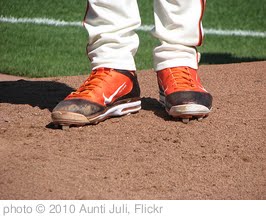 Relief pitching, by nature of the importance placed upon the role of closer (i.e. saves), is one of the hardest positions to predict with accuracy year after year. We always have guys come out of nowhere that no one even thought about selecting on draft day (Sergio Santos, Fernando Salas, Javy Guerra, Mark Melancon), and with relievers fantasy value tied so closely to a managers decision to use a certain hurler in the 9th inning, the position is a landmine that take a lot of careful navigating. How did I do in avoiding those explosive devices in 2011? Let's see.
Relief pitching, by nature of the importance placed upon the role of closer (i.e. saves), is one of the hardest positions to predict with accuracy year after year. We always have guys come out of nowhere that no one even thought about selecting on draft day (Sergio Santos, Fernando Salas, Javy Guerra, Mark Melancon), and with relievers fantasy value tied so closely to a managers decision to use a certain hurler in the 9th inning, the position is a landmine that take a lot of careful navigating. How did I do in avoiding those explosive devices in 2011? Let's see.
To see my 2011 rankings click on Top-50 Relief Pitchers.
HITS
Jonathan Axford (#6): It can be argued that he was the most effective closer in the NL as he racked up a league leading 46 saves (tied with Craig Kimbrel), while blowing only two save chances. Toss in a 1.95 ERA, 1.14 WHIP and 86 Ks in 73.2 innings and you have yourself a dominating season.
Joel Hanrahan (#10): My crowning call of the position, Hanrahan had an ADP in the late 20's or early 30's when I wrote my initial piece. Every bit as effective as Axford, Hanrahan had 40 saves in 44 chances, posted career best ratios (1.83 ERA, 1.05 WHIP), held batters to a .221 average, and posted an impressive K/BB ratio of 3.82.
Jonny Venters (#36): He was one of the 10 best relievers in baseball, though his fantasy worth wasn't that high because he only had five saves. Still, he was amazingly effective with a 9.82 K/9, a 1.84 ERA, a 1.09 WHIP and a stupendous, off the charts amazing, 5.29 GB/FB ratio.
Kenley Jansen (#39): How historic was his 2011 effort? Check out the details in Around the Horn: October 6th, 2011.
MISSES
Joakim Soria (#8): The Royals kept saying he was fine, but his performance dictated otherwise. Soria posted a three year low with an 8.95 K/9 mark, he gave up more line drive than ever before (21 percent), and for the first time had a bating average against above .220 (he finished at .259). He also saw his ERA rise by nearly two runs (4.03), posted the worst WHIP of his career (1.28) and had a four year low in saves (28).
Matt Thornton (#13): He had an epically bad first two weeks of the season, and while he recovered late in the year, the damage was done and he was never given another chance to pitch in the 9th inning. He posted solid numbers (3.32 ERA, 9.50 K/9, 3.17 BB/9) but it was far below expectations.
Jonathan Broxton (#14): His arm just wasn't right all year, and he eventually had to shut things down after multiple starts and stops. In the end he had seven saves in just 12.2 innings of work, needed elbow surgery to remove “loose bodies,†and now faces an uphill battle to return to significance in 2012.
Brad Lidge (#16): He was supposed to be healthy in late April, and the club didn't trust Ryan Madson at all. Well, Lidge's injury lingered leading to only 19.1 innings pitched (1.40 ERA, 1.50 WHIP, 1.77 K/BB) while Madson excelled as a closer for the first time (32 saves in 34 chances).
Ryan Franklin (#20): I did something I never do here – I went with role over skills. What did it get you if you made the same mistake, something I ALWAYS preach against? How about one save, an 8.46 ERA, 1.84 WHIP over 27.2 innings of work.
Craig Kimbrel (#23): I wasn't sure if he would close 100 percent of the time for the Braves which is why I had him so low on the list. Shame on me. I broke down how amazing he was in 2011 in Around the Horn: October 6th, 2011.
Alexei Ogando (#49): That's right, how quickly things can change. At the time the original piece was written on March 10th, 2011, Ogando was still in the mix to possibly close for the Rangers (they were still contemplating using Neftali Feliz as a starter). We all know what happened as Ogando was inserted into the starting rotation and had a strong season for the Rangers (13-8, 3.51 ERA, 1.14 WHIP).
By Ray Flowers
